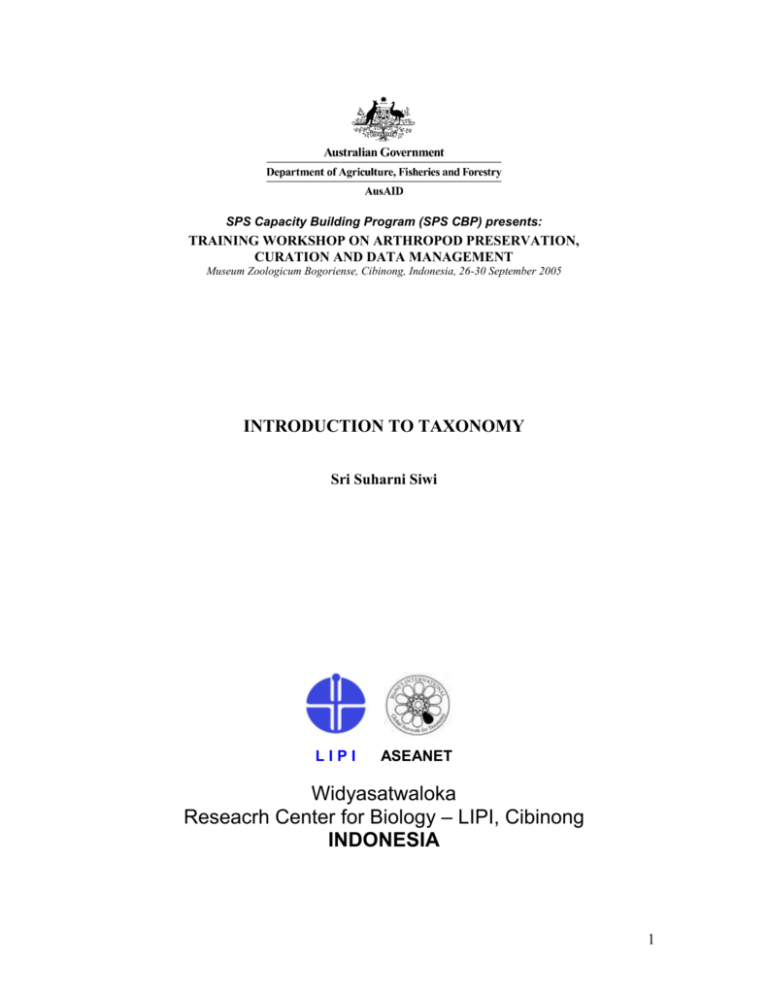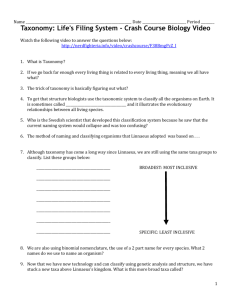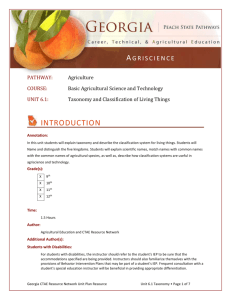INTRODUCTION TO PRINCIPLES OF TAXONOMY
advertisement

SPS Capacity Building Program (SPS CBP) presents: TRAINING WORKSHOP ON ARTHROPOD PRESERVATION, CURATION AND DATA MANAGEMENT Museum Zoologicum Bogoriense, Cibinong, Indonesia, 26-30 September 2005 INTRODUCTION TO TAXONOMY Sri Suharni Siwi LIPI ASEANET Widyasatwaloka Reseacrh Center for Biology – LIPI, Cibinong INDONESIA 1 INTRODUCTION TO TAXONOMY Sri Suharni Siwi Principles of taxonomy is an interesting tool, need to understand concept and meaning between Taxonomy, Systematic and International code of nomenclature. Taxonomy or Systematic, two terms that more or less synonymously. As suggested by Hawksworth and Bisby (1988), taxonomy is only a part of systematic. Taxonomy in this sense includes a range of different areas from description and naming of new taxa (nomenclature), classification and construction of identification system for particular groups of organisms. Systematic includes traditional taxonomy with the addition of theoretical and practical aspects of evolution, genetics and speciation. The study of the evolutionary relationship between organisms is usually referred to as phylogenetics. Terms and Concepts ☻ Taxonomy ☻ Systematics ☻ Classification Taxonomy (Greek, taxis = arranged; nomos = law) ☻ Making and maintaining collection ☻ Differentiating species ☻ Identification (Keys) and diagnosis of species and genera ☻ Naming and describing species and genera 2 Systematics (Greek, systema = a whole made of several parts) ☻ Develops the classification of organisms ☻ Species comparison and grouping into higher categories ☻ Organisms are arranged in definite, hierarchical order ☻ The order of the system is based on hypotheses of common descent ( “ Study of the kinds and diversity of organisms and the relationships between them”) In determining whether or not a specimen belongs to a new taxon, more objective criteria might be needed, for example what relationships exist between the members of a group of taxa, or where to draw dividing lines between higher taxa. In the 1960s, two new ideas of systematic emergence, one known as numerical taxonomy, nowadays referred to as phenetics (Sneath and Sokal, 1973). As the name implies, numerical taxonomy consists of applying various mathematical procedures to numerically encoded character state for organisms under study. The products of these operations were often taken to be “unbiased” indicators of the similarity or difference between the taxa, which were in turn used to arrange taxa in a hierarchy as indicators of phylogeny. At about the same time, a series of very different works were being published by Hennig (1950, 1966), and lead to a revolutionary in taxonomic thinking. Hennig’s vital contribution to modern systematics was the combination of emphasizing that phylogenetic reconstruction can only be based on shared derived features and a methodology for phylogenetic analysis based on this principle. The early ideas about species were formulated out of the practical need for naming and identifying different kinds of organisms. Species 2000 (http://www.sp2000.org), has the objective of enumerating all known species of organisms on earth as the baseline 3 dataset for studies of global biodiversity. Around 1.8 – 2 million described species, world species richness around 10.million species and still around 10 million has not yet been described. The number of described species of insect around 950.000. Topics of Interest ☻ Nomenclature and Types ☻ Classification and hierarchies ☻ Traditional taxonomic resources ☻ Data Types ☻ Speciation and Variation ☻ Phylogeny ☻ Molecular diagnostics ☻ characters and character states 4





![[Type text] Taxonomy and Classification Notes Taxonomy: the study](http://s3.studylib.net/store/data/006833839_1-e22256a74f9158844d75d24ddb12e551-300x300.png)


